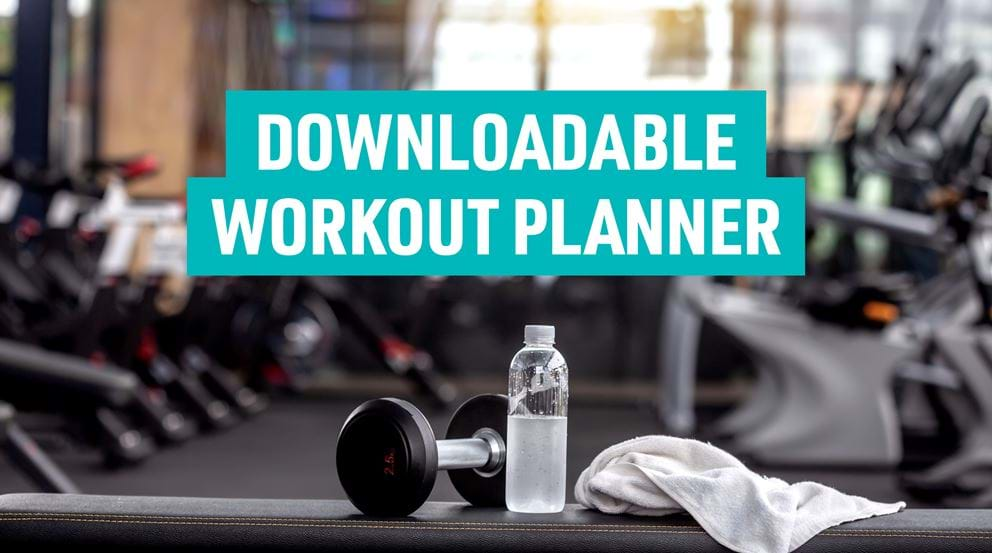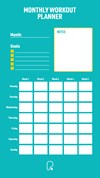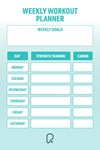Workout Plans: Download Our Templates Or Learn How To Create Your Own

Benefits Of A Workout Plan | Workout Plan Templates | What To Include | How To Make Your Own | Example Training And Workout Plans
If you’ve ever got to the gym and realised you have no idea what to do that day, or you try different things each workout but have seen little progress as a result, you could benefit from a workout plan.
In this blog we look at how you can create your own workout plan and what should be included. Or, if you’d prefer to spend less time planning and more time working out, you can choose from one of our free downloadable workout templates.
What Are the Benefits Of A Workout Plan?
Working out without a plan isn’t necessarily bad – all exercise is beneficial, whether it’s planned or not! But there are multiple benefits to having a workout plan in place to guide your weekly or monthly fitness routines, including:
-
Helps to set and achieve goals. Creating a workout plan gives the opportunity to define and set your fitness goals, which makes it easier to plan tailored workouts that will help you to achieve these goals, rather than doing exercises that won’t be as beneficial. It also makes it easier to track your progress which helps with motivation, as you can see how far you’ve come.
-
Faster progression. Having a fitness plan is the best way to ensure you are continually getting better. While random workouts can certainly help with your fitness levels, following a plan allows you to track your ability and work to progress towards your goals.
-
Consistency. Creating a workout plan can help you to workout more consistently, as you have a set plan in place – it’s easier to skip the gym when you don’t have a dedicated workout you need to do. Having a plan can also help with motivation, meaning you’re more likely to stick to your workouts and make exercise a regular part of your lifestyle.
-
Improved confidence. Our 2022 fitness report showed that 56% of both gym-goers and non-gym members find going to the gym to be an intimidating experience. Going to the gym with a plan can help to alleviate these nerves and give a confidence boost, as you know exactly what you want to do and what equipment you need, so you don’t feel like you’re aimlessly walking around. If a piece of kit you want to use is busy, you can do your other exercises while you wait.
-
Reduced risk of injury. When you are working towards a goal, it’s easy to overdo it! Having a plan that is tailored to your current fitness level and any medical conditions or injuries helps to keep you on track while preventing overexercising and minimising the risk of injury.
-
Creates variety. While it’s important to repeat your workouts over time to progressively overload, it’s also important to include a variety of exercises! This helps to keep things interesting, challenge the body, and also prevent repetitive injuries from occurring. Without a plan, you may find yourself doing the same exercises or workouts each day as it’s easy to remember, but this can actually stall progress and overwork the muscles and tendons used in those movements. A plan allows you to look across the week and make sure there’s a variety of moves that will help you to achieve your goals.
-
Unlocks health benefits. Regular exercise has numerous health benefits, including improved cardiovascular health, increased strength and endurance, better mood, and reduced stress. Having a workout plan can help you achieve these benefits and make the right moves to improve your overall health and wellbeing.
Four Downloadable, Printable, Free Workout Plan Templates
If you've never made a workout plan before, it can be difficult to know where to start. That’s why we’ve created these example workout plan templates for you to use - there's daily, weekly, and monthly workout planners to try. They’re printable, so you can write down your plans and keep them visible for reference. You can even take the daily planners with you to the gym to inform and track each workout.
Monthly Workout Planner
The monthly workout planner can be used to map out your intentions for the month – how many strength and cardio workouts do you intend to complete each week to achieve your goals?
This can be planned out in as much detail as you like, but top level (e.g. ‘strength days’ and ‘cardio days’) is a great place to start. Once you know how many days you intend to workout, you can decide on the best workout split, and from there begin to plan the workouts themselves.

Weekly Workout Planner
The weekly workout planner can be used to refine your plans and schedule your strength and cardio workouts for the week, taking into consideration any plans you have and making sure you leave rest between working the same muscle group twice.
While you may want to workout on the same days each week, there may be times when life gets in the way. A weekly workout planner can help to plan around any events and ensure you still get your workouts in, without overworking!

Daily Workout Planner - Two Options
The daily workout planner can be used to plan each workout in full, including the exact exercises you want to do, and the volume you are aiming for. We’ve designed our daily workout planners so you can track your workouts too, which makes it easier both to progressively overload and to track your progress, and one of the templates includes a section for notes and scoring so you can monitor how hard you found the workouts too.
Click on the templates to download the full size.
What Should Be Included In A Workout Plan?
There isn’t one single best workout plan, and different people will include different things depending on their goals.
When creating your own workout plan, or filling in our templates, some elements you may want to include are:
-
Warmups and cool downs. While not everyone chooses to write these down in their plan, it’s important that your workout does include them. If you’re prone to forgetting things, writing it down in your plan can be very helpful. We’ve written about the benefits of warming up and cooling down, as well as some warm-up exercise examples here.
-
Strength training. Strength training isn’t just for those looking to build big muscles. It builds strength, helps to create a toned look, increases endurance, improves bone health, and more – everyone can benefit from adding strength training into their workout plan. You’ll want to determine what exercises you plan to do each workout, and how many reps and sets you’re aiming for. Learn more about strength training and its benefits here.
-
Cardiovascular exercise. Cardio is important for improving heart and lung health, increasing endurance, and burning calories which can help with weight management. When adding cardio to your plan, include what type, what intensity, and how long you want to do it. For example, a 40 minute easy run and 15 minutes HIIT sprints are both cardio, but very different!
-
Flexibility and mobility training. Having a good range of motion helps to boost strength, joint health, prevent injury, increase overall performance, and improve pain. Adding mobility and flexibility training into your plan will help to maintain and increase your range of motion. This could be a dedicated training session each week, yoga, or just 15 minutes of stretching before and after your workouts. Check out our mobility and flexibility hub for more ideas.
-
Rest and recovery days. Tempting as it may be to hammer the gym every day, rest days are essential for helping the body to recover and get stronger, as well as preventing injuries. While alternating your workouts can help to give each muscle group a rest while training on consecutive days, you should factor in at least one full rest day a week too. Learn more about rest days here.
-
Check ins. When planning your monthly workouts, it can be helpful to plan in days to check in on your progress. For example, if your goal is weight loss, planning a day each month to take measurements. If your goal is to lift a certain weight or run a specific distance, you could plan in days to test these.
How To Make Your Own Workout Plan
If our downloadable templates aren’t right for you, then you can easily create your own workout plan template for free using tools like Excel or Word, or even your phone's notes app. There’s also a wealth of free and paid-for workout planning apps, some of which can help guide your exercise plans, and others which give you the freedom to make your own.
Once you have your template, these are the best steps to follow to actually shape your workout plan.
-
Determine your fitness goals. The first step in creating a workout plan is to really understand your fitness goals. Do you want to build muscle, improve cardiovascular health, lose weight, recover from an injury or increase flexibility? You can then use these goals to help determine the type of exercises and routines you should include in your plan. Having an overarching goal is great, but make sure you’re also breaking these down and setting yourself realistic targets that are achievable too.
-
Assess your current fitness level. Before starting your workout plan, it's helpful to assess your current fitness level. Depending on your goals, this could involve taking measurements, tracking your weight and body fat percentage, or performing fitness assessments to gauge your strength, endurance, and flexibility.
-
Determine workout frequency and duration. Decide how often you will work out and how long each workout will be. This will depend on your schedule and fitness goals, but the NHS recommends at least 150 minutes of moderate-intensity activity or 75 minutes of vigorous-intensity, plus two days of strengthening activities every week, so try to aim for this as a minimum.
-
Choose your exercises and routines. Once you know how often you plan to work out, you can plan your workout routines! You may find it easiest to choose a workout split, and from there pick exercises that will help you to hit your goals for each workout.
-
Track your progress. Tracking your progress helps to keep you motivated and ensure you’re progressing towards your goals. Log your workouts in your daily workout planner, or via an app, and track strength and body re-composition changes so you can see how you improve, or whether you need to alter workouts to reach your goals.
-
Reassess and adjust your plan. Over time, your fitness will increase, and your goals may change, so you may want to adjust your workout plan accordingly. We recommend sticking with the same plan for at least 6-8 weeks to allow enough time to progress, and you may prefer to stick with it for even longer. However, factoring in time to assess and adjust your plan can be helpful.
-
Be flexible. While it's important to follow your workout plan consistently, it's also important to be flexible with your plan as needed. For example, if you're feeling particularly fatigued or have an injury, you may need to take a rest day or modify your workout. This isn’t a failure, it’s simply listening to your body and your needs.
-
Celebrate your achievements. Finally, don't forget to celebrate your achievements and milestones along the way! Whether it's hitting a new personal record or completing a challenging workout, taking the time to acknowledge and celebrate your progress can help you stay motivated and committed to your plan.
Remember, everyone's workout plan will be different based on their goals and fitness levels, so it's important to tailor your plan to your individual needs and abilities. If you're not sure where to start, consider working with an expert personal trainer who can help create you a plan that will match your needs and goals.
Example training and workout plans for you to try
- Gym workout plans for beginners
- Workout plan for gaining muscle
- 6-week weight loss workout plan
- Run 5K training plan
- Run 10k training plan
- Half marathon training plan
- Marathon training plan
If you’re ready to improve your fitness and get started on your workout plans, you can find a PureGym near you and become a member today. Our gyms are filled with high-quality weights machines, free weights and cardio equipment, so you can start getting stronger and fitter today.




